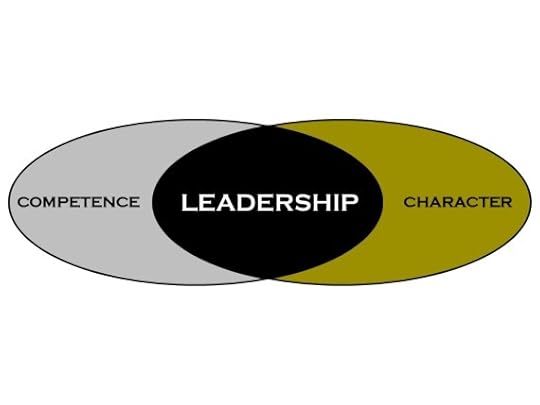Dave Anderson's Blog, page 13
October 11, 2016
How Do Leaders Get Character?
If you are like me, you’ve read a number of leadership books and they are begining to sound alike. Many of the early readers of Becoming a Leader of Character thought the same thing. Here is one quote from an early reviewer:
I have been observing and teaching about leadership for over 30 years as an executive. While there are many books written about leadership, this is the only book I have ever seen or read that actually taught someone how to develop the right character.
Becoming a Leader of Character is available today at most online retailers and in bricks and mortar stores starting today, October 11, 2016!
Click on the video below to learn more.
Click on logo below to order from the retailer of your choice

October 6, 2016
Imagine Leaders Who Speak With Clarity
“If you ever find yourself trying to read me, stop it. I am not intentionally being vague. I am just being a bad communicator at that moment.” This statement became part of my introduction to people joining my team.
Most people reacted to that statement in two ways. Some seemed relieved. Some were confused. Whether it was relief or confusion, both reactions were the result of working on teams where they spent too much time trying to figure out their boss.
Get Rid Of Vague Communications
Imagine a workplace where no one spent time trying to read between the lines. Imagine a boss that spoke with clarity and encouraged clarifying questions. That was the type of team I wanted to create. (Imagine a family like that….)
It’s About Trust
A leader who leaves people guessing at the leader’s motives or expectations is hard to trust. Think about it. Is it easy to trust someone when you don’t understand them?
So what prevents leaders from speaking clearly? It usually boils down to three issues:
Fear, Pride and/or Laziness
Fear-They are not sure what they stand for.
Too many leaders are wishy-washy. Too many change their values and priorities with the wind. We must all take the time to figure these things out and then hold to them tenaciously.
I need to know what’s important to me. If I am not sure of the values I want my team to have or what priorities they should embrace, then how can I communicate clearly? Click on the following title to read more about knowing what you stand for: Values – What Do You Stand For?
Pride – They are unwilling to confront or be confronted.
Too often leaders offer up vague direction or answers because their pride does not allow them to make a stand. They are afraid they might be wrong.
Some leaders vilify people who ask them clarifying questions when they do not understand. They can’t stand the idea they might be wrong.
Pride and insecurity are often two sides of the same coin.
I encouraged my people to ask clarifying questions if they were unclear about anything I said. I am sure I was a poor communicator on certain occasions. But my goal was not to avoid being challenged. My goal was to have impact when I spoke.
Laziness – They are not willing to put in the effort.
Speaking with clarity takes effort. Some people don’t give enough information. Some people give too much. And some people communicate in a meandering sort of way. If a leader does any of these three things, a team is left guessing.
A leader needs to take the time to think through what needs to be remembered and how that it is best communicated. What are the priorities and what is just fluff? The time spent preparing the message will often determine whether the message has an impact.
The Bottom Line:
Building trust between the leader and the led requires clear communications. I always trusted a leader when I knew where I stood and what that leader expected.
Leaders need to speak in black and white terms when it comes to moral and ethical issues. Not knowing where and when my leader will take a stand will never allow me to trust them.
Who wants to work for someone that they don’t trust. As a leader, I may be a good person and feel I am trustworthy. But, that will not matter if my people are unclear about what is important to me.
The only way I can be sure my team, or my family for that matter, has that type of clarity, is to improve my communications. I must put fear, pride and laziness aside and strive to be easy to read.
Question:
Why do you think leaders are vague in their communications?
Dave Anderson is coauthor of Becoming a Leader of Character – Six Habits that Make or Break a Leader at Work and at Home with his father General James L. Anderson (USA Retired).
You can order Becoming a Leader of Character on Amazon by clicking here:
bit.ly/LOCBook.
You can also find Becoming a Leader of Character at Barnes and Noble, Books-a-Million and other retailers.

October 4, 2016
Two Battles All Leaders Must Fight
Character is the reason most leaders fail, but what causes most of our character failures? Why do some leaders succumb to the temptation to lie or cheat? Why do others avoid confrontations or demean their subordinates? Why do micromanagers micromanage?
Honestly, most resources do not go deep enough and get to the root cause of these failures. They just say, “Don’t do this,” or “Do this instead.” When writing our book, we realized we needed a different approach. We wanted to find the real cause for character failures, and we think we found the cause—actually, two causes!

As we began to outline our book Becoming a Leader of Character and determine the six Habits of Character leaders need to develop to become Leaders of Character, we placed Integrity at the very top of the list. We were not alone. Over and over again, great leadership experts and best-selling leadership books place Integrity first. This makes sense. Integrity is a critical Habit of Character that will determine whether people trust you, believe in you, and follow you.
Still, through our study on the topic of Integrity and through our own lives and observing the lives of other leaders, we recognized that to have Integrity we must first have Courage.
Fear
Fear is constantly working inside of us, convincing us to stay quiet because some action or choice is not worth the risk. That led us to ask, “Is it truly Integrity if we only tell the truth when there is no risk involved?” Fear prevents a lot of people from stepping forward and doing the right thing. Therefore, Integrity requires Courage! The great eighteenth-century British statesman Edmund Burke once said,
“The only thing necessary for the triumph of evil is for good men to do nothing.”
And many times good men and women do nothing because they lack the needed Courage to step out and challenge evil.
With that revelation, we looked at other topics on leadership and realized that Leaders of Character must have Courage to engage in positive conflict, to trust their people, or to put the needs of others ahead of their own needs.
Pride
Then we asked ourselves, “What other character flaws are at the root of most failures?” When we looked at issues such as micromanaging, arrogance, not listening to others, selfishness, and bad attitudes, the common denominator in those failures involved pride.
In the Judeo-Christian tradition, pride was the original sin that caused Adam and Eve to eat the fruit God had forbidden them to eat in the Garden of Eden. You don’t have to be a Jew or a Christian to know that pride is present in all of us to some degree. Pride emerges in the form of either arrogance or insecurity, which are really two sides of the same coin. And they are the root cause of many leadership failures. Pride is an insidious character flaw that contributes to our leadership failures and our personal failures as well.
The opposite of pride is Humility. This virtuous habit is critical to becoming a Leader of Character and exhibiting Habits of Character, such as Duty, Selflessness, and Positivity.
Consider the items below:
Integrity
Trust
Conflict resolution
Coaching and developing others
Listening skills
Open communication
Selflessness
Empowering others
Accountability
Holding others accountable
Results orientation
Attitude
Mentoring others
Performance management
Delegating
These traits and behaviors can be found on lists of core competencies many companies embrace. Human resource departments develop these for management classes that training departments teach. These are all leadership topics that companies, consultants, and authors try to address in order to improve leaders.
I can make an argument that fear and pride are the root cause for most of the failures experienced in the above areas. It doesn’t matter how these failures present themselves, whether in areas of integrity, trust, conflict resolution, or others. If we want to change the effectiveness of our leadership development efforts, we have to start at the root cause of the issues: fear and pride.
The Bottom Line:
To effectively counteract fear and pride, we must begin with the critical development of Courage and Humility—the two character habits that directly defeat fear and pride. If we fail to do this, we will keep treating the symptoms of leadership failures rather than their causes.
You see, I believe that 90 percent of all our failures in character can be traced back to an issue of fear or pride. This is why Part 2 of our book focuses on the habits of Courage and Humility.
We contend that without these two Habits of Character, the other habits we explore in Part 3—Integrity, Selflessness, Duty, and Positivity—are not possible. To some degree or another, Courage and Humility play a role in determining which Habits of Character we excel in or fail in.
We can all look back at our lives and see failures large and small. When we work our way down to the root cause of most of those failures, fear or pride and sometimes both are usually present. That is why Courage and Humility come first in our book and should come first as we all address our own character development.
Question:
Where do fear and pride create problems for you?
(above excerpt adapted from Part 2 of Becoming a Leader of Character)
Dave Anderson is coauthor of Becoming a Leader of Character – Six Habits that Make or Break a Leader at Work and at Home with his father General James L. Anderson (USA Retired).
You can order Becoming a Leader of Character on Amazon by clicking here:
bit.ly/LOCBook.
You can also find Becoming a Leader of Character at Barnes and Noble, Books-a-Million and other retailers.

September 29, 2016
Three Decisions That Destroy Comfort Zones and Mediocrity
“If you want to accomplish something you have never accomplished before you must start doing things you have never done before.” Those words hit me hard a few years ago. The truth is:
Your Comfort Zone is Also Your Mediocrity Zone
If you want to be average – if you want to be the same person in five years that you are today, then stay in your comfort zone. That was what I was doing. I never set out to be mediocre, but I was heading towards it at the end of my corporate career.

Comfort Zones Create Mediocrity
I had been very successful and become very comfortable in my role in a large Fortune 50 corporation. I was stuck. I was stuck in my comfort zone and sliding toward mediocrity.
Mediocrity Is Easy
“If you keep doing what you have always done, you will keep getting what you already got!” While grammatically clumsy, this quote sums up where I was, and where many people are.
The easy thing to do is to keep on the path we have been on, and then wonder why our view never changes. The current path is comfortable and predictable. The current path is safe and easy.
If that’s where someone is and he/she is totally satisfied with the results, I say, “God bless and God’s speed!” But if that’s where someone is and he/she is dissatisfied, then it is time to make some decisions.
1. Decide To Do Something Hard
Do I keep in my comfort zone or do I do something hard? That was the question in front of me. It is the question in front of many of us.
Do I choose my comfort or my growth?
I knew if I chose to stay on the comfortable and easy path, I had to quit complaining about the results my choice was producing. It would be my choice to stagnate in my comfort zone or to grow outside of it. Therefore, I had no right to complain.
I made the decision to do something hard, and I have grown more since then than I ever imagined. I am doing things I never thought I’d be doing.
I’m a keynote speaker heading to China for a speaking tour there, a blogger of over 400 articles, and now a published author trying to get the word out on Becoming a Leader of Character!
How am I going to do it? I am working on that…. I am way out of my comfort zone and would never go back to my old way of operating.
2. Decide to Shut Out the Naysayers
There were people who questioned my decision. They meant well. I listened to their counsel. But in the end, I realized most of the naysayers were operating in their comfort zones as well.
Some of them were happy where they were and not complaining. Some were dissatisfied but too entrenched in their comfort zones to make a change themselves.
When I began to ask the people who had chosen a new path, their feedback was overwhelming:
“I have no regrets and I never looked back!”
Our comfort zones are like the gravitational pull of a planet. The larger the planet the stronger the pull.
In the same way, if I continue to surround myself with people who value their comfort over their growth, the pull to remain comfortable will be strong.
To break away from our comfort zones, we need to shut out the naysayers and develop our new course to follow.
3. Decide on a Destination
If you don’t have a destination, any path will take you there.
For some people this is a personal destination: “What was I designed to do?”
For others this is a professional destination: “What is our team’s ultimate measure of success?”
We all should decide on what our destination is before we should change the path we are on. In a previous blog, I discussed the process I went through and now recommend to individuals and companies I work with.
To read more about this process, click on the following title:
Vision: Am I Enjoying the Ride.
The Bottom Line:
As Andy Dufresne said in the great movie The Shawshank Redemption: “You have to either get busy living or get busy dying.” He was trying to avoid being too comfortable and dying in prison. Andy Dufresne escaped.
When a tree stops growing it starts dying.
I had to choose mediocrity or choose growth. And if I chose my comfort zone and the ensuing mediocrity, I needed to stop whining about my situation because it was my choice.
My dad once told me: “Everything is hard before it get’s easy.” My old job was hard and uncomfortable for a while. That was when I enjoyed it the most because I was growing. When it became comfortable, I became dissatisfied.
Now my challenge is to not allow this new chapter in my life to become too comfortable. I do not see that happening any time soon. Maybe that is why I am enjoying this chapter so much!
Now, like the others who broke out of their comfort zones:
I have no regrets and I am never looking back!
Question:
How does your comfort zone keep you from growing?
Dave Anderson is coauthor of Becoming a Leader of Character – Six Habits that Make or Break a Leader at Work and at Home with his father General James L. Anderson (USA Retired).
You can order Becoming a Leader of Character on Amazon by clicking here:
bit.ly/LOCBook.
You can also find Becoming a Leader of Character at Barnes and Noble, Books-a-Million and other retailers.

September 27, 2016
What is a Leader of Character
“Character is higher than intellect.” – Ralph Waldo Emerson
Leadership speaker and author John Maxwell jump-started the trend of defining leadership as influence. I agree with him and the leadership experts (such as Oswald Sanders) whom Maxwell cites as his inspiration. But does that definition go far enough? Does just having influence make someone a leader?
 Along with influence, the direction we lead another person toward is important. Hitler had influence, but what he led people to do was horrific. Stalin had influence. Bin Ladin had influence too. But the goals of each of these leaders were immoral and incredibly damaging to generations upon generations of people. I believe that motives, among other things, separate the Leaders of Character from the rest.
Along with influence, the direction we lead another person toward is important. Hitler had influence, but what he led people to do was horrific. Stalin had influence. Bin Ladin had influence too. But the goals of each of these leaders were immoral and incredibly damaging to generations upon generations of people. I believe that motives, among other things, separate the Leaders of Character from the rest.
I also maintain that there should be some level of achievement involved in leading. Leaders of Character are different than people who just wield influence. Who cares if I have influence on others, but the influence is not used to accomplish any concrete, beneficial goals?
A movie critic has influence, but whom are they leading? A talking head on CNN or Fox News has influence, but are they leading anyone towards something positive? Do they help others accomplish any goals?
No one would deny that Hitler and Jesus, Stalin and Ghandi, and Bin Ladin and Abraham Lincoln were leaders. They all had influence. But not all of them were Leaders of Character. Leadership—at least any leadership of genuine value—must be more than mere influence. It matters for what purpose that leadership is used, what goals are being pursued.
Andersons’ 12-Word (or less) Definition of a Leader of Character
Someone who uses influence to achieve a moral or ethical goal
The type of goal a leader is aiming at defines whether he is a Leader of Character or just a person of influence. The bottom-line is this: when you try to differentiate a Leader of Character from the rest of the so-called leaders out there, look at their motives.
Leadership is a blend of competence and character
A Story From Gen James L. Anderson
My friend and West Point classmate General Norman Schwartzkopf helped me solidify my leadership philosophy. I was preparing to leave the military and was telling Norm about my plans to start my own leadership consulting business. That was when he asked me, “Jim, what’s your niche?”
I told him my philosophy was that leadership was a blend of competence and character. He thought for a second and then added, “Jim, I agree. But did you ever stop to think that most failures in leadership are failures in character and not failures in competence?”
Character Is Why People Follow
The bottom line is character is why people follow leaders. Another way to see this is to look at the biggest leadership failures we know. These could be people featured in the news, people from history, or people we personally know. When you think about those failures, were those failures in competence or as a result of character flaws?
Why Do Leaders Fail?
Fear, arrogance, lapses in integrity, selfishness, poor work ethic, bad attitudes—these are the causes of most leadership failures. Rarely is it a case that someone couldn’t do the job due to competence issues. Usually it is a result of that leader having a character issue that caused their downfall.
Did Nazi Germany collapse because Hitler and his party did not know how to run an efficient government or war machine? Or was it because Hitler was one of the most amoral and evil men of the twentieth century?
Did Bernie Madoff’s investment empire collapse because he didn’t know how to manage money, or was it an issue of Integrity?
Did Enron implode because the company leaders did not know how to run an energy trading company, or was it an Integrity issue? Or was it a Courage issue on the part of some leaders?
Did FIFA not know how to promote soccer worldwide and how to generate an enormous fan base? Or was it the selfishness of the people indicted for fraud and corruption that put the whole organization in jeopardy?
The Bottom Line:
Am I saying competence is not important? Absolutely not! Incompetence in a leader is incredibly damaging. Competency is a hugely important part of the leadership equation. Hiring, developing, and reinforcing leadership competence are critical for organizations and individuals to remain competitive. Leaders must be competent in certain management skills.
In fact, over and over again—in big and small businesses, in for-profits and non-profits, in the government and in the private sector—the search for and almost exclusive emphasis on competence reigns. We continue to hire, train, and evaluate people based on competencies. But, as we have repeatedly found, the inability to do the job is rarely why leaders fail—character is!
That is why some people have begun calling me a Character Evangelist. Because character needs to become our focus in leader development.
Question:
What are you doing to develop your character and the character of those you are called to lead?
Dave Anderson is coauthor of Becoming a Leader of Character – Six Habits that Make or Break a Leader at Work and at Home with his father General James L. Anderson (USA Retired).
You can order Becoming a Leader of Character on Amazon by clicking here:
bit.ly/LOCBook.
You can also find Becoming a Leader of Character at Barnes and Noble, Books-a-Million and other retailers.

September 20, 2016
Three Rules To Leading Peers
“What can I do? If I step up and try to lead my peers, I don’t think they will follow. I’m not as direct as you are Dave. ”
The quote above is representative of a lot of conversations I have inside of companies who ask for my help. There are many people who know they should be a leader among their peers. They just aren’t sure how to accomplish it.

What do I attract?
“But, what if my peers do not want to be led? What if I have never been expected to lead my peers before? What if I have never done it before? “
Peer leadership is not easy for many people because they are stuck on the how. “How do I lead my peers?”
Three Rules To Leading Peers
Leading peers is not easy. Leading peers who are leaders themselves is especially tough. But, whether we are talking about leading peers on the front lines or leading peers in the boardroom there are three rules that will build your influence with your peers.
1. Attitude Attracts Attitude
Whatever attitude I display, I will attract people of similar attitudes. Conversely, I will repel people carrying the opposite attitudes. One way I can lead my peers is through my attitude.
While misery loves company, so does joy. Joyful people attract joyful people. If I see the opportunities versus the challenges, if I see the potential in people instead of the failures, if I look for reasons ideas will succeed versus reasons they won’t, I will attract people with a common attitude.
As I consistently portray a positive attitude, my influence on those around me will grow. We all enjoy spending time with people who have a good attitude. They make us want to be like more like them.
The attitudes I exude attract similar attitudes. A peer with a positive attitude will always attract followers. Conversely, a negative person has few followers.
I must ask myself the old question:
“Attitudes are contagious. Is mine worth catching?”
2. Selflessness Attracts Selflessness
As Rick Warren wrote in The Purpose Driven Life, “It’s not about me.”
If I have not figured out the world does not revolve around me, then I may never be able to lead my peers effectively. Selfishness attracts selfishness and selflessness attracts selflessness.
I think we have all been on a team where selfish behavior reigned. When each person looks out for number one, it is a miserable team to be a part of. But one person acting selflessly has the power to turn a group of selfish peers into a selfless and sharing team.
When one person is more concerned about the good of the team and aiding others, than she is about helping herself, the power of her example increases her ability to influence peers.
I believe many selfish behaviors at work take hold because people think they must act that way to get ahead, or just keep up. But, if I truly want to be a leader among my peers I need to do the exact opposite.
I need to be selfless. I need to realize that my example will motivate others to act similarly. Selfless acts attract selfless acts. I can lead my peers by being selfless. It only takes one person. If I want to lead, then it should be me.
3. Courage Attracts Courage
Who’s going to step forward and act? That first person has Courage. But that act of Courage often attracts others to act courageously as well.
In battle, one person’s courageous example can turn a demoralized unit into an unbeatable force. (See William Wallace in Braveheart or Joshua Chamberlain in Gettysburg,)
In my life, the first time I spoke out against joining 8 guys at a Gentleman’s Club to watch a football game, I was joined by 2 of the crew at a local sports pub instead. One person needs to speak up against the crowd. That’s all it takes to inspire others to follow.
Courage attracts Courage. With a group of peers it takes one person to speak up against a poor plan or a morally questionable decision to spur others forward.
To lead my peers, I need to act with Courage and not quietly follow others down a bumpy path. When I step away from that path, I will rarely be alone. My courageous example will attract the Courage in others.
The Bottom Line:
I always wanted my teams to be made up of leaders. A team full of peer leaders is a strong team. On this type of team initiative thrives, accountability is expected, accepted and people are fully engaged.
John Maxwell says, “Leadership is influence.” Among peers, the only way to truly lead is through influence because I do not have positional authority over my peers.
I grow in influence among my peers when they see my actions and emulate them. To be a peer leader my actions will influence my peers more than eloquent words. When I set the example with my Positivity, Selflessness and Courage, I will attract similar responses from those I intend to lead.
Question:
How else can peers lead their peers?
Dave Anderson is coauthor of Becoming a Leader of Character – Six Habits that Make or Break a Leader at Work and at Home with his father General James L. Anderson (USA Retired).
You can order Becoming a Leader of Character on Amazon by clicking here:
bit.ly/LOCBook.
You can also find Becoming a Leader of Character at Barnes and Noble, Books-a-Million and other retailers.

September 15, 2016
What’s A Shepherd Without Sheep
Question 1: Are sheep without a shepherd still sheep? Answer: Yes.
Question 2: Is a shepherd without sheep still a shepherd? Answer: No.
A shepherd without sheep is just a hygienically challenged man walking the countryside with a stick in his hands.
Leaders: It is the people that make you a leader not the title!
Early in my career, I was struggling as a young sales leader and was looking for answers. My team liked me and I liked my team. But, our results were bad.
I was their leader in title, but few were following. I was that guy in the hills…except for my almost OCD like need to shower.
One Sunday as our pastor went through a sermon series on leadership, I had a revelation. I’d been reading all these leadership books by John Maxwell and Ken Blanchard, but all the answers I needed could be found in one book! The Bible.
Before anyone floats away to a less faith heavy blog, read on. I am not going to use this blog to preach on the power of God’s word. If you want to talk about that, email me at dave@alslead.com. I would be happy to talk to you real voice.
I share the story about that Sunday morning as background for my thoughts on how Leaders of Character and shepherds are synonymous. The details are worth looking up, but that is up to you. (John 10)
5 Lessons Leaders Should Learn From Good Shepherds
1. Good Shepherds Go In Front of Their Flock
In business this means a Leader of Character leads by example. As a Leader of Character, I must be willing and actively model what I expect others to do. Too often leaders say they lead from the front, but no one actually sees them modeling the behaviors they expect.
To have followers, I must not just tell people where to go, I must lead by modeling so my sheep know the path.
2. Good Shepherds Know Each of Their Sheep
Too many of us have been led by people who don’t even know our names when we shake their hands. Leaders of Character know details about the people they lead. One key element is knowing the personality style of each person they lead and how to best communicate with them.
When someone knows that they are known by me, they follow because they believe that I care about my sheep.
3. Good Shepherds Are Known By Their Sheep
For my people to know me, I must communicate with them. Leaders of Character communicate consistently with those they lead. Because of this consistent flow of communication, their people are comfortable hearing from the boss.
Leaders of Character are not closed books. They allow their people to see them as real people. They share things about their lives outside of work, and have the Humility to admit they are fallible.
When I am known because of the frequency and the manner in which I communicate, my sheep will respond to my voice.
4. Good Shepherds Will Make Sacrifices For Their Sheep
A Leader of Character sees herself working for the good of her people not vice versa. Leaders of Character spend time with their people while emails stack up.
A Leader of Character listens longer than she wants to and will sacrifice her own wants and desires for the good of those she is leading.
In the case of a shepherd, they will fight off wolves and the attacks of rustlers to protect their flock.
There may not be a life or limb-threatening situation at my job. But, as a good shepherd I will actually sacrifice myself for the good of my flock.
5. Good Shepherds Feel Ultimately Responsible For Their Flock
Leaders of Character own their results. It does not matter if they are the owner of the company or a mid-level manager, Leaders of Character feel responsible for everything their team does.
If a leader’s attitude is that of a hired hand, they are likely less involved, less dependable and less willing to lead in the four ways discussed above.
A shepherd who owns his flock, knows that he is ultimately responsible and that blame doesn’t matter. If the sheep end up at the bottom of a cliff, or they survive a thunderstorm, it is ultimately the shepherd’s responsibility.
I must believe I am responsible for my people and my team’s results. I hold myself accountable and will not run from difficulties or deflect blame to other people.
The Bottom Line:
Some people believe it is the position that gives them ability to lead. But 2000+ years ago the most influential man to ever walk this earth taught otherwise. It does not matter if I call myself a leader if no one is following.
If I lead from the front, know my people, am known by my people, serve those I lead and feel responsible for each individual on my team and their results, my people will follow and I will be a Leader of Character.
Question:
Which of the five lessons above have you seen done extremely well by a good shepherd you know?
Dave Anderson is coauthor of Becoming a Leader of Character – Six Habits that Make or Break a Leader at Work and at Home with his father General James L. Anderson (USA Retired).
You can find Becoming a Leader of Character on Amazon by clicking here:
bit.ly/LOCBook.
You can also find Becoming a Leader of Character at Barnes and Noble, Books-a-Million and other retailers.

September 7, 2016
Over-Analysis Causes Me Headaches
Every time people around me use statements or questions from the list below, I feel an aneurysm coming on. They make my head hurt just reading them.
“We need to study this further.”
“Are you sure?”
“But what if…”
“We need to cover all our bases.”
“Can we run some more numbers?”
“Who’s going to be responsible?”

Is This An Aneurysm?
Uncertainty Dominates
Leaders must thrive in uncertainty. As leaders, we can rarely obtain all the information we want to have before making decisions. It is either unavailable or it would take too long to get it.
Uncertainty dominates our world. As leaders we must accept that fact. Uncertainty must be overcome by our desire to move forward and grow.
I have seen the unwillingness of people to embrace uncertainty prevent progress in many arenas. In business, non-profits, church leadership, and families, fear of uncertain circumstances or uncertain outcomes creates a culture of inaction and over-analysis.
I have written about this subject many times:
Mistake Proof Equals Growth Proof
Leadership Inertia
The Indecisive Leader
The Risk Averse Leader
Ready, Shoot, Aim
I am an action-oriented person. Often when I error, it is because I belong to the school of Ready, Shoot, Aim.
The school of thought that gives me the headaches are the people who want certainty before they make a decision. Their mantra is Ready, Aim, Aim, Aim…
But, I realize my way of doing things can cause problems as well. People like me need the analytical types to slow me down. I need someone to point out the details I tend to overlook.
A leader must be willing to listen. I must know myself and be open to feedback from people who are different from me. These people keep me out of trouble! They can give me headaches, but I need them!
Ready, Aim, Aim, Aim….
An analytical leader does not have to be as action oriented as some of us are. But, just like me, they need to have the opposite personality advising them to move forward. I may give that person a headache, but they need me too!
A leader who errors on the side of over analysis must still make decisions and make them in a timely manner. To avoid paralysis through analysis, the leader must have someone who is willing and able to communicate the need for action.
Who’s Responsible?
It is a fact.
If my team is stuck in the conference room in a never ending debate on what to do next, I am responsible.
If my team is running after one shiny new idea after another without seeing real results, I am responsible.
As a leader I am responsible for what happens on my team. Period. My circumstances, my people, my boss, the economy all have influence on the outcomes. But, I am ultimately responsible.
I am responsible for knowing my strengths and my weaknesses. They are often the same thing. I need to take the time to look at who I am and how I tend to operate. Without that level of self-examination, the most certain thing is my future is the status-quo.
The Bottom Line:
One type of leader is not better than another. However, no matter where a leader falls on the analysis spectrum – Zero to Paralysis – we must all have our opposite nearby and be humble enough to listen to them.
Communicating with my opposite can be difficult and can even induce aneurysms for me. But, understanding who I am and how I tend to behave is my first step towards finding a balance between action and analysis.
Uncertainty is a certainty for leaders. A leader waiting on all the answers will spend her life waiting. Decisions must be made. In today’s world, the ability to make quick decisions is more important than ever.
I am a big believer that an 80% solution implemented now will always beat a perfect solution that is still in development. As I have matured as a leader, I realized I need help getting to the 80% while others need help stopping at 80%.
Question:
Where is uncertainty keeping you from moving forward?
Dave Anderson is coauthor of Becoming a Leader of Character – Six Habits that Make or Break a Leader at Work and at Home with his father General James L. Anderson (USA Retired).
You can find Becoming a Leader of Character on Amazon by clicking here:
You can also find Becoming a Leader of Character at Barnes and Noble, Books-a-Million and other retailers.

September 1, 2016
Three Reasons To Speak Up
If I challenge my boss, she will thank me. If I speak up for what is right, my boss will not persecute me. If I fight for my integrity despite pressure from above, I will always keep my job.
None of these results are guaranteed if I do the right thing. The only time I have a guarantee is if I stay silent. My silence guarantees things will stay the way they are. Speaking up is the only way change may happen.

Speak Up and Make Change Happen
Too many of us are stuck. We are stuck in situations where we feel powerless to make change happen. We are stuck in an organization or with a boss who is at best ineffective and at worst amoral. What should I do?
The Three Reasons To Speak Up
1. Things Could Change
By speaking up, I have given change a chance. An ineffective leader may need my insights and thrive on them. I had some very good people on my teams who challenged me when I was ineffective. They made me better.
2. My Integrity Is Intact
Whether or not I cause change to happen by speaking up, I will sleep better. My integrity is 100% in my control. Only I can choose to sacrifice it. Even the times I spoke up and was shot down, I knew I did my Duty to change the outcome. That always gave me peace no matter the outcome.
3. I Empower Others
By speaking out, I empower others. Courage attracts courage. My comments may not have immediate impact on the current situation. But, I have found that when I was willing to step out the next time, I often had a partner or two.
Silence Guarantees Results
If I want guaranteed results, then I need to stay silent. My silence will insure the status quo is maintained. In a situation where a team or organization is being led down the wrong path, I don’t like that option.
If things are bad enough for me to moan and groan to my peers or to my wife, but I say nothing to my leadership, I deserve the status quo. I have chosen a guaranteed result versus the possibility of improvement.
Silence Is Easy
Silence is the easiest route to take. I have done it. There is a lower possibility of encountering personal pain or upheaval. There is also a guaranteed possibility of continued misery in my current situation.
The Bottom Line:
The fact is I will never strike out if I stay in the on deck circle practicing my swing. But, if I want it to be possible for me to hit the ball, I need to step up to the plate and take a swing.
I might make contact! I might get a hit! I might even get a home run!
It’s not guaranteed, but speaking up makes change possible!
Question:
What situation have you avoided speaking up about?
Dave Anderson is coauthor of Becoming a Leader of Character – Six Habits that Make or Break a Leader at Work and at Home with his father General James L. Anderson (USA Retired).
You can find Becoming a Leader of Character on Amazon by clicking here:
You can also find Becoming a Leader of Character at Barnes and Noble, Books-a-Million and other retailers.

August 30, 2016
Sometimes Being a Leader Sucks
“This is one of those times when being a leader sucks.” It was all I could really say to this young leader I was recently coaching. She knew what she had to do and that it was not going to be easy or comfortable.
Hard decisions are part of being a leader. Whether we are a CEO, a middle manager, or a front line employee – Whether we are a coach, a team captain, or an underclassman – Whether we are a husband, a mother, or a child. When it is time to step up and lead, no matter our title, being a leader can really suck.
But if I consider myself a Leader of Character, I must be willing to make those tough decisions even if I do not like making them.

10 Times Being a Leader Sucks
When you fire someone you liked and believed in, but they didn’t perform well.
When you fire a top performer because of their bad attitude and negative influence on your team.
When you tell your boss about something your team screwed up.
When you confront a teammate about her immature behavior.
When you work hard on the parts of your job that you hate doing.
When you are a coach and bench your best player before the big game because of his off the field behaviors.
When you tell the truth to your supervisor, while everyone else has decided to lie.
When you stay late at work to help a teammate finish her work.
When you tell a friend what he needs to hear instead of what he wants to hear.
When you confront your boss about her treatment of other employees.
The Choices Leaders Make
In each situation above, the leader has a choice. The leader has the choice to do nothing, choose the comfortable thing, or choose to do the right thing. Doing the right thing is the choice a Leader of Character consistently makes. But, it does not mean that doing the right thing is always enjoyable.
In fact, choosing to do the right thing will often come at a personal cost. The choice could make your life harder. The choice could put you on an island alone with your values. The choice could make other people angry, and they may not understand.
But, a Leader of Character does not make choices based on whether others will like the decision. They understand that when it comes to choosing between right and wrong, they will likely have to choose something that will make other people unhappy.
The Bottom Line:
Anytime I thought leadership was getting easy, the Good Lord would put something in front of me that reminded me that leadership sucks sometimes. This is how leaders grow from being a common leader to becoming a Leader of Character. They choose to do the things they know are going to suck, simply because they are the right things to do.
Being a Leader of Character takes Courage. Being a Leader of Character takes Humility. Being a Leader of Character takes Selflessness. If as a leader we choose to be courageous, humble and selfless, there will be some times that being a leader sucks.
Leadership is not for the faint of heart. The rewards can often come years later when a former employee or player sends you an email or calls and thanks you for being the uncommon leader who was willing to do the hard things, because they were the right thing to do.
Choosing the path of least resistance usually ends up turning into the highway to hypocrisy. The easy choice will lead us to become something we never intended to be. The hard choice may suck in the short term, but the rewards are well worth the discomfort.
Question:
What aspects of leadership do you avoid because they may suck?











